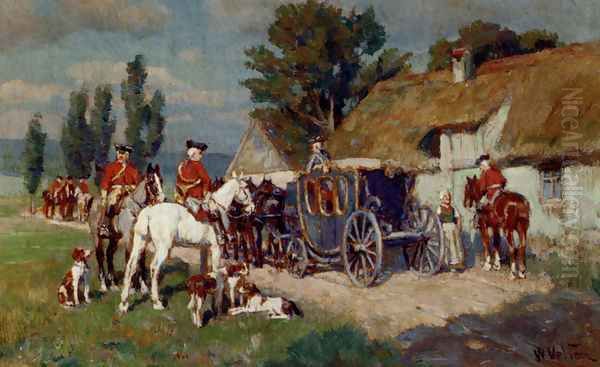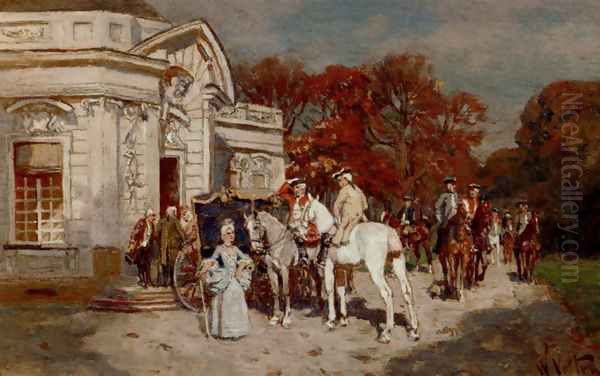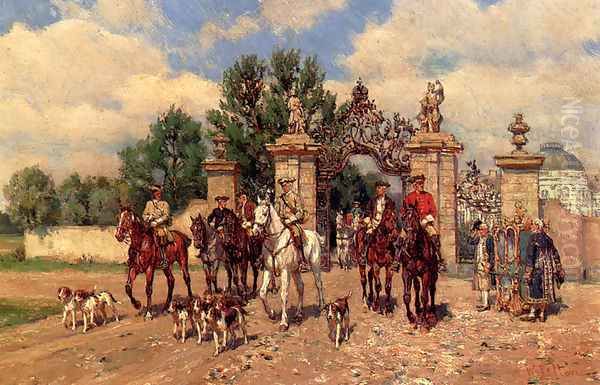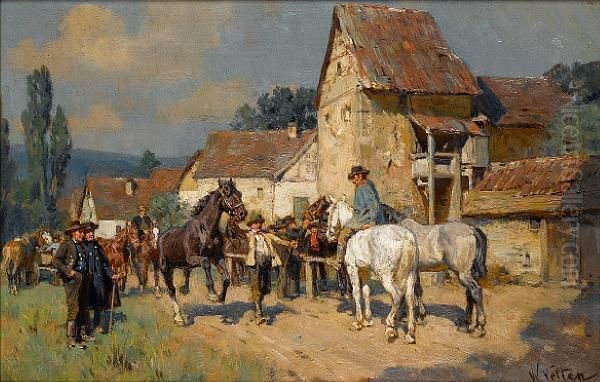Wilhelm Velten stands as a notable figure in Russian art history, particularly recognized for his skillful depictions of equestrian subjects, hunting parties, and scenes drawn from historical contexts. Born in the imperial capital of St. Petersburg in 1847 and passing away in 1929, Velten's career spanned a period of significant artistic evolution in Russia and Europe. He carved a distinct niche for himself as a painter adept at capturing the dynamism of horses and the specific atmospheres of both aristocratic leisure and military life.
Velten's work is characterized by a meticulous attention to detail and a clear affinity for realism, often infused with a romantic sensibility towards the past. His paintings serve not only as aesthetic objects but also as valuable visual documents of cultural practices, particularly the traditions of the hunt, and the appearance of historical settings and attire, often focusing on the 17th and 18th centuries.
Early Life and Artistic Formation
Born into the vibrant cultural milieu of St. Petersburg, Wilhelm Velten's initial artistic inclinations were likely nurtured by the rich environment of the Russian capital, home to the prestigious Imperial Academy of Arts. While details of his earliest training remain somewhat scarce, it is documented that he sought further artistic education abroad, a common path for ambitious Russian artists of the time seeking exposure to Western European trends and techniques.
His journey led him to Munich, a major European art center rivaling Paris in the latter half of the 19th century. In Munich, Velten had the significant opportunity to study under Wilhelm von Diez (1839-1907). Diez was an influential painter and professor at the Munich Academy of Fine Arts, known for his historical genre scenes, animal paintings, and landscapes, often rendered with a painterly realism characteristic of the Munich School. This tutelage undoubtedly played a crucial role in shaping Velten's technical skills and thematic interests.
The Munich Influence: Wilhelm von Diez and Realism

Studying under Wilhelm von Diez placed Velten directly within the orbit of the Munich School, a significant force in German art. Diez himself was celebrated for his ability to depict historical scenes with accuracy and atmospheric depth, as well as his skill in rendering animals, particularly horses. His teaching emphasized careful observation, solid draftsmanship, and a realistic approach to subject matter, often combined with a certain narrative flair.
This environment would have honed Velten's abilities in precisely the areas that became central to his oeuvre: the accurate depiction of animal anatomy, the detailed rendering of costumes and accoutrements, and the creation of convincing historical or contemporary genre scenes. The Munich School's broader emphasis on realism and technical proficiency provided a strong foundation for Velten's artistic practice. Other artists associated with or influenced by the Munich School's realism during this period included figures like Franz von Defregger, known for his scenes of Tyrolean peasant life and history.
Core Themes: The Hunt, Horses, and History
Wilhelm Velten's artistic identity is inextricably linked to his chosen subjects. He demonstrated a profound fascination with horses, capturing their form, movement, and spirit with remarkable skill. This focus naturally extended to equestrian activities, with hunting scenes becoming a hallmark of his work. These paintings often depict groups of riders, clad in period attire, either setting out for the hunt, in pursuit, or gathered during a pause, frequently accompanied by hounds.
His interest was not limited to contemporary scenes. Velten often turned his attention to the 17th and 18th centuries, painting scenes populated by figures in historical dress, engaged in activities typical of those eras. This included not only hunting parties but also depictions of soldiers, courtly life, and elegant companies in landscape settings. This historical focus suggests an appreciation for the aesthetics and perceived romance of bygone eras, a common theme in genre painting of the 19th century.
These themes resonated with certain segments of society, particularly the aristocracy and military classes, where horsemanship and hunting were integral parts of life and tradition. Velten's ability to capture these activities with both accuracy and a degree of elegance likely contributed to his appeal. His work can be seen in the context of a long European tradition of sporting and equestrian art, exemplified earlier by artists like George Stubbs in England, and contemporary German painters like Franz Krüger, known for his depictions of Prussian military parades and horses, and the Adam family, particularly Albrecht Adam, renowned for battle scenes and horse portraits.
Artistic Style and Technique

Velten's style is firmly rooted in realism. His paintings are characterized by fine, detailed brushwork and a commitment to accurate representation. He paid close attention to the textures of fabrics, the sheen of a horse's coat, the details of tack and weaponry, and the specific features of the landscape. This meticulous approach lends a sense of immediacy and authenticity to his scenes, whether contemporary or historical.
His compositions are typically well-structured, effectively arranging figures and animals within landscape settings to create dynamic or narrative focal points. The use of light and color contributes to the mood, often capturing the specific quality of daylight in outdoor scenes or the richer tones appropriate for historical subjects. While detailed, his realism generally avoids the photographic, retaining a painterly quality consistent with the Munich School's influence.
Compared to some of the major movements unfolding in Russia during his lifetime, such as the socially conscious realism of the Peredvizhniki (Wanderers), Velten's work occupied a different space. While artists like Ilya Repin, Vasily Surikov, or Ivan Kramskoi focused on critical depictions of Russian society, history, and the lives of ordinary people, Velten's art often centered on more traditional, sometimes aristocratic, themes rendered with technical polish rather than overt social commentary. His landscape elements, while skillfully done, also differ from the profound, emotive landscapes of contemporaries like Isaac Levitan or Ivan Shishkin.
Representative Works
Several titles associated with Wilhelm Velten give a clear indication of his thematic preoccupations. Works such as A Hunting Party Ready for the Off likely depict the moments of anticipation before the chase, showcasing riders, horses, and hounds in a landscape setting, emphasizing the details of dress and equipment. Elegant Company at a Summer House suggests a scene of leisure, perhaps featuring well-dressed figures enjoying an outdoor gathering, allowing Velten to display his skill in rendering costumes and social interactions within a pleasant natural environment.
The Departure is another title indicative of a narrative moment, possibly involving travelers, soldiers, or perhaps another hunting party setting out. Auction records also mention works like Riding with Hunting Companions in the Forest and Hare Hunt, further cementing his reputation as a specialist in scenes of the chase. These paintings, through their detailed execution and specific subject matter, contribute significantly to our understanding of Velten's artistic focus and skill. Another Russian artist known for his mastery of horse painting, though perhaps with a different stylistic emphasis, was Nikolai Sverchkov.
Velten in the Context of Russian and European Art

Wilhelm Velten operated during a dynamic period in art history. In Russia, the late 19th and early 20th centuries saw the flourishing of the Peredvizhniki movement, the rise of Symbolism, and the beginnings of the avant-garde. Velten's adherence to a more traditional form of realism, influenced by his German training and focused on specific genres like equestrian and historical scenes, set him somewhat apart from these dominant trends. However, his work represents a significant strand within the broader tapestry of Russian art, catering to tastes for finely crafted genre painting and depictions of traditional life, including aristocratic pursuits.
His connection to the Munich School places him within a wider European context. Munich was a cosmopolitan center attracting artists from across Europe and America. Velten's themes and style find parallels in the work of other artists active there, including Polish painters like Alfred Wierusz-Kowalski, who also specialized in dramatic scenes often featuring horses, snow, and wolves, or German artists focused on historical and military subjects, like Peter von Hess, who had earlier worked in Russia as well. Velten's work can also be compared to French animaliers like Rosa Bonheur, who achieved international fame for her realistic depictions of animals.
Social Activities and Historical Impact
While specific records of Wilhelm Velten's involvement in particular artists' groups or social activities beyond his training and professional practice as a painter are not readily available from the provided information, his historical impact lies primarily in his artistic output. His paintings serve as valuable cultural artifacts, preserving visual records of activities like the traditional Russian hunt, which held significant social and cultural meaning.
His depictions of historical scenes, particularly those referencing the 17th and 18th centuries, contribute to the visual imagination of Russia's past, reflecting a 19th-century interest in history and national heritage. The meticulous detail in his work provides insights into period costume, military uniforms, and equestrian practices. Furthermore, the enduring presence of his works in collections and their appearance at auction indicate a continued appreciation for his technical skill and chosen subject matter.

Velten's contribution was perhaps less about innovation in artistic language, unlike some of his more radical contemporaries, and more about the proficient and dedicated exploration of specific genres. He excelled in capturing the elegance and energy of horses and the detailed pageantry of hunting and historical scenes. In doing so, he created a body of work that celebrates a particular aspect of Russian culture and demonstrates a mastery of realistic technique learned in one of Europe's leading art centers. His paintings offer a window onto specific facets of Russian life and history, rendered with a skill that secured his place among notable Russian painters of his time, alongside figures known for different specializations, such as the portraitist Valentin Serov, who also occasionally depicted equestrian subjects with great flair, or the earlier master Karl Bryullov, representing the academic tradition.
Legacy
Wilhelm Velten's legacy rests on his position as a skilled Russian painter specializing in equestrian themes, hunting scenes, and historical genre subjects. Trained in the rigorous environment of the Munich School under Wilhelm von Diez, he developed a style characterized by detailed realism and careful execution. His works capture the dynamism of horses and the specific atmospheres of aristocratic pursuits and historical settings.
While perhaps not aligned with the major avant-garde or socially critical movements of his time in Russia, Velten's art holds historical and cultural significance. It provides a visual record of traditions like the hunt and reflects a 19th-century engagement with history. His paintings continue to be appreciated for their technical accomplishment and their evocative portrayal of a world centered around horsemanship, landscape, and historical narrative. He remains a respected figure within the specific, yet significant, niche of Russian genre and animal painting.